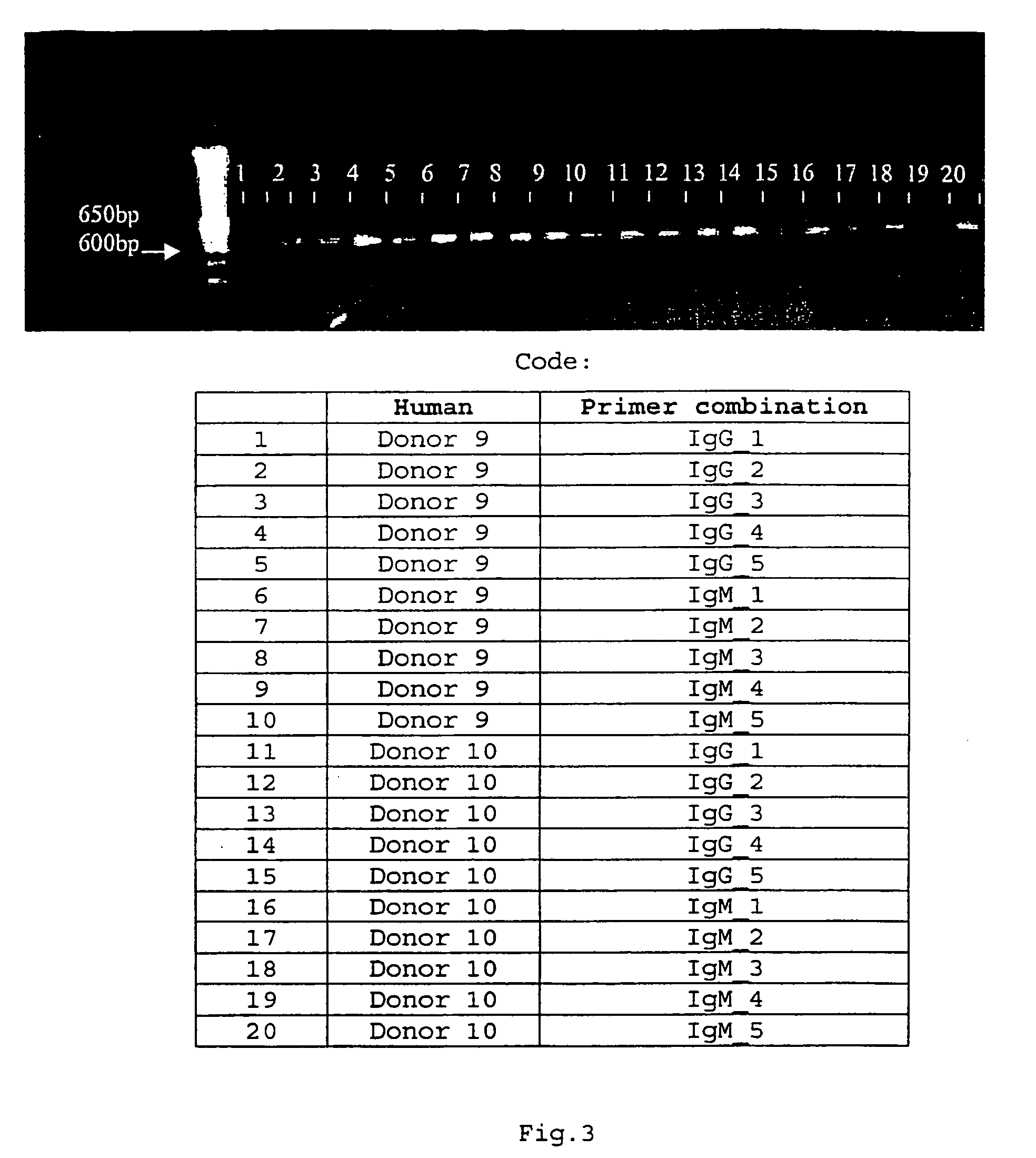Method for displaying loops from immunoglobulin domains in different contexts
a technology of immunoglobulin and loop, applied in the direction of immunoglobulins against cell receptors/antigens/surface determinants, cell receptors/surface antigens/surface determinants, carrier-bound/immobilised peptides, etc., can solve the problems of difficult production, fragments which were isolated were barely soluble, and the approach has not been successful, so as to increase the conformational stability of anti-parallax -strands
- Summary
- Abstract
- Description
- Claims
- Application Information
AI Technical Summary
Benefits of technology
Problems solved by technology
Method used
Image
Examples
experimental examples
Example 1
Construction of Human Naïve VH and VH Micro-Scaffold ( VHμs) Libraries
[0092] The naive VH and VHμs libraries are built in parallel, following the procedure shown in FIG. 2. The first three steps (RNA isolation, cDNA reaction and amplification of human heavy chains) are common for both libraries. The obtained PCR fragments of the primary amplification of the heavy chains are then used as template for the construction of the VH and VHμs libraries.
RNA Isolation
[0093] mRNA from peripheral blood lymphocytes (PBL) from 10 healthy donors was extracted as described by Chomczynski et al., 1987. Briefly, after isolation of the PBL on a Ficoll-Hypacque gradient, the cell pellet was dissolved in 8 M guanidinium thiocyanate, 25 mM citric acid, 17 mM N-lauroyl sarcosine and 0.1 M β-mercapto-ethanol. Chromosomal DNA was sheared by passing through a 19 Gauge needle and a 23 Gauge needle. Next, two phenol-chloroform extractions followed by two ethanol precipitations were performed. RNA...
example 2
Construction of Llama Dedicated VHH and VHHμs Libraries
Llama Immunization
[0109] Two llamas were immunized according to animal welfare regulations. A cocktail of antigens (IL-6, TNFalpha, IgE, Von Willebrandt Factor, I domain, Ghrelin, Motilin, GpIb, Carcino Embryonic Antigen (CEA)) was formulated in Specol adjuvant. The immunization scheme used is depicted in Table 3.
TABLE 3Immunization scheme of llamasImmunizationSamplingDayLlama 2Llama 4Llama 2Llama 40Max doseMax dose150 ml blood150 ml blood7Max dose14½ dose21½ doseMax dose28½ dose 10 ml blood 10 ml blood35½ dose39150 ml blood +lymph node42½ dose150 ml blood45150 ml blood70½ dose74150 ml blood +lymph node80150 ml blood
VHH Library Construction
[0110] RNA was isolated from blood and lymph nodes according the method described by Chomzcynski and Sacchi, 1987. cDNA was prepared on 100 μg total RNA with M-MLV Reverse Transcriptase (Gibco BRL) and a hexanucleotide random primer (Amersham Biosciences) or oligo-dT primer as described...
example 3
Selection on Chemokine Receptors CXCR4 and CCR5 by using Naïve VH, VHμs and VHHμs Libraries
[0129] Human glioma cells expressing CD4 and human chemokine receptors CXCR4 or CCR5 (Centralized Facility for AIDS Reagents, NIBSC, UK) were grown in 85% DMEM, 15% heat inactivated foetal calf serum, 300 μg / ml G418 and 1 μg / ml of puromycine to confluent monolayers in 6 well culture plates. 1013 phages / phagemid particles of the VH, VHHμσand VHμs library with a diversity of 1010 unique clones for human libraries and 107 unique clones for the llama library were incubated in 1 ml culture medium with the adherent glioma cells for 3.5 hrs at 4° C. Following 5 washes with culture medium with 5 minute incubation between the washes, bound phages / phagemids were eluted for 10 minutes with 0.1N glycine pH 2.2. After neutralization with 1M Tris-HCl buffer pH 8.1, eluted phages / phagemids were used to infect exponentially growing E. coli TG1 cells. Bacteria were plated on LB agar plates with 100 μg / ml ampi...
PUM
| Property | Measurement | Unit |
|---|---|---|
| volume | aaaaa | aaaaa |
| reaction volume | aaaaa | aaaaa |
| volume | aaaaa | aaaaa |
Abstract
Description
Claims
Application Information
 Login to View More
Login to View More - R&D
- Intellectual Property
- Life Sciences
- Materials
- Tech Scout
- Unparalleled Data Quality
- Higher Quality Content
- 60% Fewer Hallucinations
Browse by: Latest US Patents, China's latest patents, Technical Efficacy Thesaurus, Application Domain, Technology Topic, Popular Technical Reports.
© 2025 PatSnap. All rights reserved.Legal|Privacy policy|Modern Slavery Act Transparency Statement|Sitemap|About US| Contact US: help@patsnap.com



